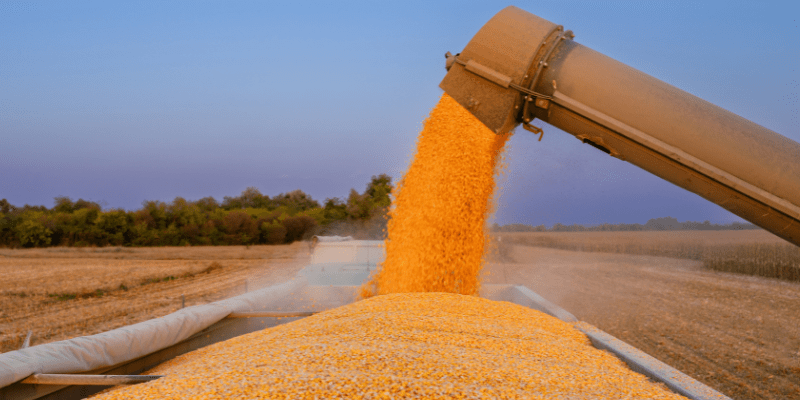Grain entrapment: 5 tips to plan, prepare and prevent tragedy

“A grain entrapment situation can be fatal within minutes,” cautions Ryan Dick, Health and Safety Consultant with WSPS. “Particularly when there’s not a lot of planning ahead of time.” As Ryan describes how quickly someone can suffocate when they are trapped by flowing grain, it becomes clear that having others around who know what to do and who can act quickly will make the difference between life and death.
“Once you are buried in grain up to your knees, it’s almost impossible to get yourself out,” explains Ryan. “When you move one foot, the other will go down further into the grain. So, if you struggle, you will push yourself down deeper. And when you are buried up to your chest, the pressure of the grain on your chest cavity will prevent you from being able to inhale.” There is also the issue of breathing in dirty air when you are surrounded by grain, which is why Ryan recommends wearing a respirator when working around flowing grain.
What is your rescue plan?
Ryan emphasizes how critical it is to have an established rescue plan, the necessary equipment close by, and people trained on what to do. Having a group working together rather than one person working alone is good, but if they don’t know what to do in the moment, it won’t make a difference. “If a worker walks across the top of a bin and a bridge breaks, that worker will fall in. There is more than a good chance that they will die while others are trying to figure out what to do,” says Ryan. This is why it is imperative to have a plan in place and people ready to take action.
Workers must be trained on how to safely secure or rescue someone who is entrapped in flowing grain until additional rescue services can arrive. Making the wrong move could further endanger the trapped worker. “And it’s not enough to do a training session once and not think about it again until an incident occurs. You need to repeat and refresh training on a regular basis to ensure everyone knows exactly what they are supposed to do if an incident occurs,” says Ryan.
5 ways to reduce your risk of grain entrapment
The safest thing to do is to avoid going inside grain bins and trucks as much as possible. “New technology, such as sweeping augers, can reduce how often someone needs to actually get inside a bin,” he says. “Sensor systems can help as well.”
However, even with the latest technology, there will still be times when a worker has to go into a bin or ends up having to climb onto the back of a truck. “For these situations, you need to minimize the risk as much as possible by preparing in advance,” says Ryan. In addition to having an established rescue plan and trained workers, do these things to reduce the risk of grain entrapment, if you can’t find an alternative method to accomplish the task.
- Never work alone. In most cases, the only chance of getting free from flowing grain is if others rescue you. Schedule work accordingly and communicate so no one finds themselves moving or storing grain on their own. Always have workers present who are trained to perform a rescue.
- Train your workers and establish safe work practices. Identify the hazards that workers will face when working with flowing grain. Then, develop check-ins and safe work procedures that include controls to minimize the risks. For example, ensure lifelines and lanyards are worn when someone is working in flowing grain, along with respirators are provided. You can also make it a regular practice to check the bins and wagons before unloading grain to ensure no one is inside unexpectedly.
- Become familiar with the specific equipment on the farm. There are several types of grain bins, wagons, and augers with varying levels of technology. Make sure everyone who will work near this equipment has completed training so they know where the openings are, how grain is expected to flow, the type auger being used, how to override any automated feature in the event of a malfunction, and how to properly lock out and tag the power sources where possible.
- Practice good grain management. Ryan explains the importance of knowing the properties of the specific types of grain you are working with and training others. Understand how the grain will behave at different moisture levels and in certain weather conditions. Avoid storing grain when crop moisture levels are higher than desired and try not to transfer grain while its raining to minimize any additional moisture being introduced.
- Keep grain bins in good condition. Regular maintenance is key. Keep your bins clean, repair leaks, test sensors, use air flow screen, etc. Managing the temperature and moisture levels will help reduce the risks of bridging and having grain cling to the sides of the bin. Remember to keep the area surrounding bins free of equipment and clutter to ensure rescue services will have unobstructed access if needed.
By taking proactive steps and ensuring your team is trained and prepared, you can reduce the risk of grain entrapment on your farm.
How WSPS can help
Consulting
Connect with a WSPS health and safety consultant for help identifying hazards, implementing controls, and establishing your rescue plan.
Resources
- Check out the Farm Safety Roundup podcast for the latest episode on grain entrapment and how to protect yourself and your workers.
- Visit BeGrainSafe from the Canadian Agriculture Association of Canada
- Cultivating Safety in Agriculture (video)
- Hazard Assessments for Agriculture (pre-recorded webinar)
Training
- JHSC Certification Part 2 – Agriculture (online, instructor-led, 2 days)
- Tractor Safety (online, instructor-led, half day)
- Orientation on Health and Safety for New Agricultural Workers (eCourse)
The information in this article is accurate as of its publication date.




